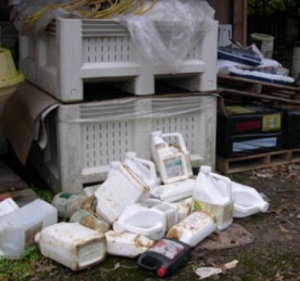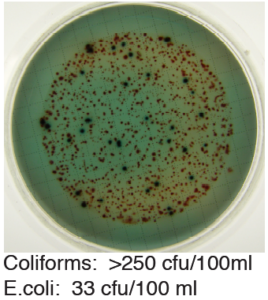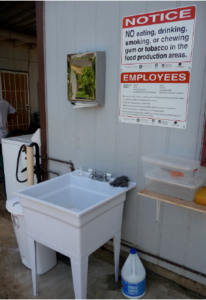As a professional grower, it is in your best interest to grow the safest food possible – no pathogens (germs) and no residual chemicals. Knowing that you are doing everything in your power to keep contaminates off your food will give you a level of comfort when you sell to wholesalers, restaurants, and consumers. They, too, have an obligation to make sure they keep your safe produce, safe. Your focus, however, will be on delivering a safe product to your buyers. The best way to look at your farm is to ask yourself, “would I treat food in my kitchen like I am treating it on my farm?”
Good Agricultural Practices (GAP) and Good Handling Practices (GHP) are voluntary audits that verify that fruits and vegetables are produced, packed, handled, and stored as safely as possible to minimize risks of microbial food safety hazards. GAP & GHP audits verify adherence to the recommendations made in the Guidance for Industry: Guide to Minimize Microbial Food Safety Hazards of Fresh-cut Fruits and Vegetables and industry recognized food safety practices.
In this unit you will find out why it is important to manage your food safety risk, how to do that, and how to get help.
Why is this important?
About 48 million people in the U.S. (1 in 6) get sick, 128,000 are hospitalized, and 3,000 die each year from foodborne diseases, according to recent data from the Centers for Disease Control and Prevention. In response to the increase in food borne illnesses, The Food Safety Modernization Act (FSMA) was signed into law in 2011 giving the Food and Drug Administration (FDA) new authorities to regulate the way foods are grown, harvested and processed. Using the practices under GAP will help growers meet expectations for the FSMA Produce Rule and audit requirements.
For growers, wholesalers, restaurants and retailers, getting people sick can cost millions of dollars in a lawsuit and perhaps the business, and the business owner’s reputation, will be destroyed. This is especially critical since many food related stories are posted on the internet, and thus could be part of your farm history forever. For a commodity, country or state to be known as the source of a food-borne illness, it can cost millions of dollars in lost revenues. The September 4, 2006 spinach E. coli outbreak which sickened more than 200 people and killed three, cost spinach growers over $77 million. No agricultural industry or state/country can afford these types of losses and consumers deserve to be sold the safest food possible.
For your farm, you need to be diligent and keep your farm clean and free of pathogens, including animals in the production and packing areas. You need to keep records of your chemical and fertilizer applications, bathroom sanitation, refrigerator temperatures, and the like. By keeping good records you will demonstrate that you are serious about the safety of the food you provide to customers.
Critical food safety issues on farms
The types of food-related risks found on Hawaiʻi farms are similar to issues found on the Mainland and worldwide. They fall into these categories:
Human hygiene
- Do you have a clean toilet for workers?
- Do workers wash their hands with soap and water for a minimum of 20 seconds after arriving to work, using the bathroom, smoking, eating, etc.?
Animals and their feces
- Are pets and wild animals found in your fields and packing shed? (hint: they should not be there at all).
- Are you using fully-composted compost or manures? (hint: all composts need to pass EPA regulations on production quality and have a lab test certifying the lack of pathogens).
- Are there animals in fields uphill from your operation where their feces could come onto your property during a rainstorm?
Water
- What type of water is “touching the edible portion of the crop” during irrigation (hint: it should be potable – drinkable, if possible).
- How is your produce wash water? It needs to be potable too – just like in your home kitchen!
Chemicals
- Are you using the correct chemicals for the crop you are growing?
- Are you using the correct safety equipment when applying chemicals?
- Do you keep records of all your chemical applications?
- Do you post signs in the field to inform workers when it is safe to re-enter a field after spraying?
- Do you follow the pre-harvest interval?
Harvest
- Are all your harvest baskets sanitized every day and kept off the soil during harvest?
- Are your harvesting tools sanitized before each use?
While there are a number of other issues, these issues, in one form or another, are showing up on Hawaii farms. Fortunately, they can be easily, and inexpensively, addressed in a timely manner.
Examples of bad and good practices
Here are a few visual examples of what is good and not so good on Hawaiʻi farms.
Animals do not belong in production or packing areas because of pathogens in their feces can be transferred to humans

Dirty harvest containers do not protect consumers

Chemicals are not handled safely on this farm

A lab sample of water on a Hawaiʻi farm

A good farm sink!

A good farm toilet!

Coaching and auditing process
You might be asking, “how do I get help?” First, you need to get some guidance or coaching on how to best overcome your farm risk factors. The University of Hawai‘i’s College of Tropical Agriculture and Human Resources (CTAHR) can help provide trained coaches who can come to your farm and coach you through the entire farm transformation process.
Next steps and resources
CTAHR’s outreach education team:
| Name: | Islands covered: | Phone: | Email: |
| Jari Sugano | O‘ahu | 808-622-4185 | suganoj@ctahr.hawaii.edu |
| Jensen Uyeda | O‘ahu | 808-622-4185 | juyeda@hawaii.edu |
| Joshua Silva | O‘ahu | 808-342-8560 | jhsilva@hawaii.edu |
| Kiersten Akahoshi (DHHL) | Hawai‘i | 808-969-8229 | kiersten@hawaii.edu |
| Elihu Isele | Hawai‘i | 808-969-8209 | elihu@hawaii.edu |
| Sharon (Motomura) Wages | Hawai‘i | 808-969-8250 | smotomur@hawaii.edu |
| Kylie Wong | Maui | 808-244-3242 *224 | kylielw@hawaii.edu |
| Lynn Nakamura-Tengan (Statewide Leader) | Maui, Moloka‘i, Kaua‘i | 808-244-3242 *233 | lynnnaka@hawaii.edu |
| Emilie Kirk | Kaua‘i | 808-274-3478 | erkirk@hawaii.edu |
| Roshan Mananhar | Kaua‘i | 808-274-3474 | roashanm@hawaii.edu |
The CTAHR food safety website can be accessed at:
http://manoa.hawaii.edu/ctahr/farmfoodsafety/
The national food safety program’s website is managed by Cornell University and contains a number of documents in various languages:
Hawaiʻi Department of Agriculture Commodities Branch Quality Assurance Division:
http://hdoa.hawaii.gov/qad/commodities-branch/
USDA Agricultural Marketing Service GAP/GHP site: